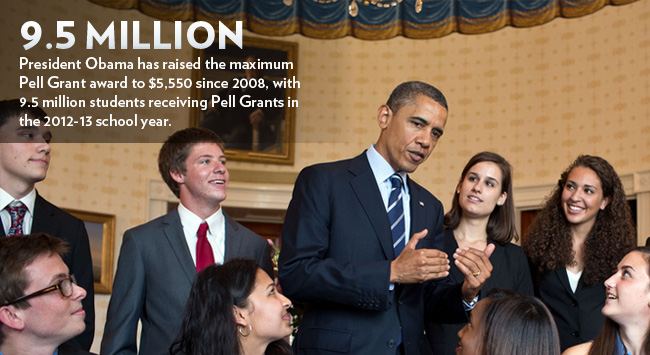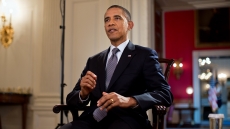EDUCATION
“If we want America to lead in the 21st century, nothing is more important than giving everyone the best education possible — from the day they start preschool to the day they start their career.”
K-12 Education
In today’s global economy, a high-quality education is no longer just a pathway to opportunity—it is a prerequisite to success. Because economic progress and educational achievement are inextricably linked, educating every American student to graduate from high school prepared for college and for a career is a national imperative. The President has articulated a goal for America to once again lead the world in college completion by the year 2020, and all of President Obama’s education efforts aim toward this overarching objective.
To create an economy built to last, we need to provide every child with a complete and competitive education that will enable them to succeed in a global economy based on knowledge and innovation. To provide a high-quality education to all American children, President Obama has advanced reforms around four key objectives:
- Higher standards and better assessments that will prepare students to succeed in college and the workplace
- Ambitious efforts to recruit, prepare, develop, and advance effective teachers and principals, especially in the classrooms where they are most needed
- Smarter data systems to measure student growth and success, and help educators improve instruction
- New attention and a national effort to turn around our lowest-achieving schools.
Since taking office, the Obama Administration has designed and implemented several initiatives to strengthen public education for students in every community nationwide:
Keeping Teachers in the Classroom

President Obama believes that our children cannot win the future if teachers are not where they belong—in our classrooms, teaching our nation’s children. America’s education system has always been one of our greatest sources of strength and global economic competitiveness, as well as an engine of progress in science, technology and the arts. Our nation cannot expect to train our children for the high-skilled jobs of today, or for the opportunities of the future, without investments in a world-class education system. And America cannot build a world-class education system without teachers in our classrooms.
But cuts to education budgets nationwide put education jobs at risk. These cuts force states and districts into difficult decisions, including laying off teachers and other school personnel, overcrowding classrooms, reducing preschool and kindergarten programs, or even shortening the school week and year.
That’s why the President has invested in education, providing funding to keep hundreds of thousands of teachers on the job over the past three years and creating a proposal to prevent further layoffs from taking place:
- Administration Investments Supported Hundreds of Thousands of Education Jobs: In 2009, the President effectively deployed stabilization funds for state education budgets through the American Recovery and Reinvestment Act, which enabled states and schools districts to keep approximately 300,000 educators on the job in the face of budget cuts caused by the economic recession. In 2010, the President signed the Education Jobs Bill into law that provided states $10 billion in emergency funding to keep approximately 130,000 educators in the classroom.
- President Obama Proposes Additional Funding for Education Jobs: In 2011, the President put forward a plan—as part of the American Jobs Act— to provide support for hundreds of thousands of education jobs, enough for states to avoid harmful layoffs, rehire teachers who lost their jobs over the past three years, preserve or extend the regular school day and school year, and support important after-school activities. President Obama proposes a $25 billion investment in the coming year to make sure we can keep teachers in the classroom.
Race to the Top

Race to the Top marks a historic moment in American education. This initiative offers bold incentives to states willing to spur systemic reform to improve teaching and learning in America’s schools. Race to the Top has ushered in significant change in our education system, particularly in raising standards and aligning policies and structures to the goal of college and career readiness. Race to the Top has helped drive states nationwide to pursue higher standards, improve teacher effectiveness, use data effectively in the classroom, and adopt new strategies to help struggling schools.
Redesigning and Reforming No Child Left Behind

As states move forward with education reforms, some provisions of No Child Left Behind — the most current version of the Elementary and Secondary Education Act, which is five years overdue for reauthorization — stand in the way of their progress. Although NCLB started a national conversation about student achievement, unintended consequences of NCLB have reinforced the wrong behaviors in attempting to strengthen public education. NCLB has created incentives for states to lower their standards; emphasized punishing failure over rewarding success; focused on absolute scores, rather than recognizing growth and progress; and prescribed a pass-fail, one-size-fits-all series of interventions for schools that miss their goals.
In March of 2010, the Obama Administration sent Congress a Blueprint for Reform of the Elementary and Secondary Education Act, addressing the issues created by No Child Left Behind while pursuing high standards and closing the achievement gap. But because Congress has not acted to reauthorize ESEA, the Administration moved forward in providing states flexibility within the law – as authorized by provisions in the law itself – to pursue comprehensive plans to improve educational outcomes for all students, close achievement gaps, and improve the quality of teaching. To date, 33 states and the District of Columbia have received ESEA flexibility.
Modernizing America's Schools

President Obama proposed a $30 billion investment in modernizing America’s schools and community colleges as part of the American Jobs Act and included in his FY13 budget proposal. These investments would enhance the condition of our nation’s classrooms to better prepare students to compete for the jobs of the 21st century. The range of critical repairs and needed construction projects would put hundreds of thousands of Americans — including construction workers, engineers, maintenance staff, boiler repairers, and electrical workers — back to work, while investing in the school infrastructure of 35,000 public schools, supporting repairs and upgrades in our nation’s community colleges, and improving the health and safety of our teachers and students.
Involving Parents in Education
![]()
Parental participation is of critical importance to the success of our nation's schools, and parents will always be a child's first and most important teacher. President Obama has called on parents to be real partners in education with their children's teachers, from cradle to career. To further encourage family engagement, the Department of Education has proposed to double funding for parent engagement to a total of $270 million, while also enhancing information and transparency in school report cards about academic performance and school climate for parents, and providing supports for programs that survey families on how their child's school and educational experience. The Obama Administration will continue to encourage shared responsibility of parent, child, and teacher to promote academic success, and we will continue to do our part in building capacity to empower parents to make informed decisions about their child’s education.













